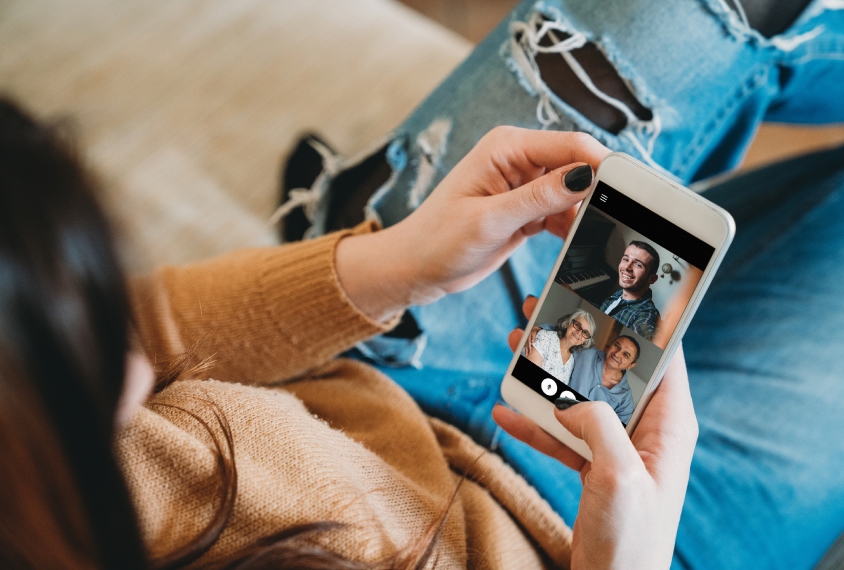“Gray skies are gonna clear up,” Susan Epstein sings into the phone.
“Put on a happy face,” sings her daughter, miles away in a group home for adults with intellectual disability. (Spectrum is withholding her name to protect her privacy.)
The two have not been in the same room in more than two months, ever since the coronavirus pandemic shut the group home to visitors in March. Singing together is one of the few ways that Epstein’s daughter, who is minimally verbal but knows the words to dozens of songs, can connect with her mother during the lockdown.
Many autistic people living in group homes are having to forgo visits with family and therapists — with good reason. Like nursing homes and cruise ships, group homes are particularly vulnerable to outbreaks of disease.
“It’s incredibly difficult to social distance in a group home,” says Julia Bascom, executive director of the Autistic Self Advocacy Network.
To date, COVID-19 has sickened and killed thousands of staff and residents in group homes across the United States. In New York state, about 300 residents of group homes have died from the virus, according to the New York State Office for People With Developmental Disabilities. And outbreaks have also hit facilities in Maryland, New Jersey and Michigan.
But as group homes put restrictions in place to try to stop the spread of the virus, residents are paying a price. Cut off from friends, family, day programs and services — sometimes without understanding why — many are struggling with frustration and anxiety.
“Autistic people have very specific routines they like to follow,” says Lauren Bishop, assistant professor of social work at the University of Wisconsin-Madison. “When those things are taken away as a result of a national crisis, it can make the crisis that’s already stressful even more stressful.”
Staffing squeeze:
People with autism or intellectually disability may be at greater risk for infection than the general population, no matter where they live. Many have underlying health conditions and may have trouble with hand hygiene and other preventive measures, experts say.
In a group home, the risks may be even higher. Residents share common areas and sometimes bedrooms, making it difficult for sick or exposed residents to self-isolate. Many also need help with bathing, dressing and eating, putting them in close physical contact with staff.
“Direct support work is up close and personal,” says Peter Berns, chief executive officer of The Arc, a nonprofit disability advocacy organization in Washington, D.C., whose local chapters run group homes and day programs. “It’s not done at a distance of 6 feet or more.”
Support staff often rotate among group homes, which makes them especially vulnerable to contracting — and spreading — the coronavirus. As workers fall ill and homebound residents need more care, administrators say they are having trouble keeping homes fully staffed and stocked with food and protective equipment.
Around 15 percent of workers at Home From Home Care, a group-home network in the United Kingdom, went into self-isolation after exhibiting signs of COVID-19 in late March and early April, says Paul de Savary, the network’s cofounder.
“We’re planning for the worst and hoping for the best,” de Savary says.
To shore up staffing, group homes have recruited furloughed workers from other disability services, such as day programs; and administrators are taking shifts caring for residents. Homes with space to spare have set aside rooms or buildings where infected people can self-isolate. And in some cases, staff are quarantining with group-home residents to minimize the chances of exposure.
Routine disruptions:
Even with these measures, many group homes are short-staffed. Residents are missing out on even virtual visits with family and therapists, says Jill Fodstad, associate professor of clinical psychology at Indiana University in Indianapolis. Fodstad says she has missed sessions with clients living in group homes, who need others to help them access video calls.
Immediately following the sudden closure of Charlie Keller’s group home in Iowa, his mother, Peg Keller, says she was completely cut off from her son. Charlie, 21, has intellectual disability and does not have his own phone or tablet.
“The first few days, the only way I could see him is if they brought him to the window,” she says.
Charlie’s brother has since lent him an iPhone for daily video calls, and the group home recently started allowing socially distant family visits once a month. But Peg worries that it is not enough contact for her son, who craves physical affection.
“He wants his head tousled; he wants you to rub his arm,” she says. “He needs that.”
Other group-home residents are coping with increased anxiety in response to disrupted routines and plans.
Before the pandemic, Bryan Shore, a 39-year-old autistic man, spent hours at a time outside of his group home each day, volunteering for Meals on Wheels through his day program. Since the program shut down, though, he is mostly staying in his room, jumping up and down to manage his anxiety. Bryan has lost weight due to the nonstop jumping, says his father, Michael Shore. Every time they talk on the phone, Bryan asks when he can return to his day program.
“Never before in his life has he been stuck in the house for this long and told by the people that he cares about that he can’t do his routine,” Michael says. “And there’s no end in sight.”





